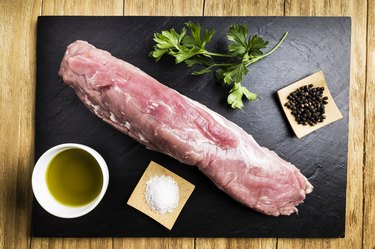
Although pork neckbones generally only have a small amount of meat on them, they can add flavor to broths, sauces and soups. When prepared correctly, boiled neck bones can be an economical standalone entree, a side dish or used to spice up greens, beans, peas and other vegetables.
Tip
Pork neckbones taste best when simmered or slow-cooked. Serve them with veggies or add them to soups, broths and stews for extra flavor and nutrition.
Video of the Day
Slow Cook Pork Neckbones
Pork neckbones are an affordable ingredient in many traditional comfort food recipes. Neck bones and potatoes pair well with other vegetables, such as carrots and Italian green beans.
Video of the Day
Boiling tougher cuts of meat in liquid is a simple cooking process that's widely used for tenderizing. Simmering the bones over low heat will help break down the collagen, or connective tissue in the meat. It also draws out marrow that contains minerals, such as calcium, according to the U.C. San Diego Health.
The key to getting all the meat off is to slow cook pork neckbones. Although you can make boiled neck bones on the stovetop, slow cookers retain heat better and maintain a more constant temperature.
To make pork neck bones in a slow cooker, place a small amount of oil in the bottom of the pot to prevent sticking. If you're adding potatoes and other vegetables, place them at the bottom of the pot because they cook more slowly than meat in moist heat, according to the University of Wyoming.
By adding vegetables, the resulting broth will add nutrients to your meal. For example, adding tomatoes and carrots will provide phytochemicals, such as lycopene and carotenoids, notes the U.C. San Diego Health. Plus, the acid in the tomatoes will help tenderize the meat.
Adding some chopped ginger to your broth can also help tenderize the meat from the pork neckbones. According to a February 2016 study published in the Journal of Livestock Science, ginger rhizome contains a powerful enzyme that acts as a tenderizing agent for tough meat. Additionally, ginger exhibits antioxidant properties.
When you're ready to add the neckbones, rinse them first to remove loose particles, excess cartilage or fat. Fill your slow cooker with water, broth or sauce to no more than two-thirds full.
The University of Wyoming recommends cooking on high heat for the first hour to quickly reach the minimum safe temperature of 135 degrees Fahrenheit and then turn the dial to low and let the temperature continue to rise slowly. The surrounding liquid should maintain a temperature of 180 to 190 degrees F to kill microorganisms.
For maximum flavor, add whole herbs and spices instead of ground forms during the last 30 minutes of cooking. Pepper, cayenne and Tabasco sauce tend to become bitter when cooked for longer periods of time. Some good herbs to use include garlic, curry, Italian seasoning and coriander.
The Nutritional Benefits of Neckbones
Pork neck bones are a good source of protein and minerals. Each cooked neckbone delivers 85.5 calories after the bone is removed, according to the USDA. Neckbones don't contain any carbohydrates, fiber or sugar. They provide 1.2 grams of saturated fats and 32 milligrams of cholesterol per piece (about 1.6 ounces).
Some important minerals in pork neck bones include:
- Calcium: 6.6 milligrams
- Iron: 0.5 milligrams
- Magnesium: 9.4 milligrams
- Phosphorus: 117 milligrams
- Potassium: 158 milligrams
- Zinc: 1.5 milligrams
- B vitamins, including thiamine, riboflavin, niacin, B6, B12 and folate
Read more: Bone Soup Nutrition
Ounce for ounce, pork neck has fewer calories than chicken necks. Pork necks deliver 0.9 grams of total fat per ounce. Chicken necks contain 3.6 grams for the same amount, but chicken necks have slightly more protein. Per ounce of beef neck bones, cooked with the bone removed, 33 calories consist of 2 grams of fat and 3.3 grams of protein, according to the USDA.
- UC San Diego Health: "Taking Stock: the Health and Hype of Bone Broth"
- University of Wyoming: "All About Slow Cooking"
- Journal of Livestock Science: "Ginger as a Tenderizing Agent for Tough Meats - A Review"
- USDA FoodData Central: "Pork, Neck Bones, Cooked"
- USDA FoodData Central: "Chicken, Neck or Ribs"
- USDA FoodData Central: "Beef, Neck Bones, Cooked"